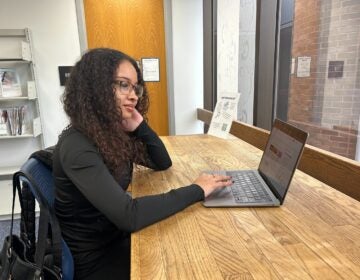How Delaware will update curriculum to represent all racial and ethnic histories
The state's educational landscape is evolving — schools are incorporating diverse racial narratives into the curriculum.
Listen 1:42
Books written by Asian-American authors can be checked out from the library within the Ginger Arts Center. (Cory Sharber/WHYY News)
From Philly and the Pa. suburbs to South Jersey and Delaware, what would you like WHYY News to cover? Let us know!
In June 2021, Delaware lawmakers approved legislation that officially requires Delaware schools to include studies on Black History for students in kindergarten through 12th grade.
Last month, Gov. John Carney signed follow-up legislation that took that effort further, requiring schools to include all racial and ethnic groups in the curriculum. The goal is to provide students with opportunities to learn about others’ experiences, see themselves reflected in the content and engage with different perspectives.
The tough work of implementing those changes into lesson plans and other schoolwork is just getting underway. Michael Feldman, education associate for social studies at the Delaware Department of Education, confirmed that the approach used for implementing Black history under 2001’s HB 198 will guide the integration of other cultural groups under this year’s SB 297.
“I think that HB 198 kind of set the table, it pushed on people’s perception of what it means to learn history, it forced us to take a look at history and take a step back and [identify] some missing pieces in the story of our country,” he said. “Our history makes more sense when we include all the pieces in that puzzle … But it also challenges us, and going on with SB 297, it challenges us to look for other pieces that have been left out of the traditional narrative.”
But because Delaware is a local-control state, the state Department of Education doesn’t broadly supply curriculum materials, even though that’s a common misconception, Feldman said. In reality, it is the local school boards that are responsible for adopting their own materials and policies.
“Districts and charter schools choose or create their own curriculum, to promote the learning of their students and their particular context,” Feldman explained. “There’s a perception out there in the public that the Department of Education provides curriculum for ELA, math, science [and] social studies, when in fact, those plans, those instructional materials, are all local.”
To support Delaware’s 19 public school districts and 23 charter schools, the DOE offers guidance for integrating culturally competent content and professional development. The department focuses on fostering cultural sensitivity among educators and assists in explaining legislation while providing a model for lesson plans and materials.
“Unpacking the legislation and really digging into what exactly is expected of each one of these districts and charter schools to implement as far as Black history,” he explained. “The department makes connections supporting districts and charter schools, but then also funding the creation of model lessons that districts can use in the creation of their local curriculum.”
The DOE collaborated with the New York Metro Center, the University of Delaware and Delaware State University, which contributed in training sessions, lesson plans and other valuable materials.
Holly Golder, supervisor of social studies at Red Clay Consolidated School District, said the first step in updating the district’s Black history curriculum involved conducting a comprehensive inventory of what has been taught in the past and identifying gaps. The next step was to collaborate with universities and organizations to create lesson plans that address those missing pieces.
“We looked to see how we could create lesson plans and units in some cases and implement Black history into what we are doing,” she explained. “Where we saw some gaps was in our K–3 classrooms.”
The Social Studies Coalition of Delaware supported Golder and her colleagues by collaborating closely with former kindergarten teacher Dawnavyn James and LaGarrett J. King. James and King work at the Center for K–12 Black History and Racial Literacy Education at the University at Buffalo, where they focus on how Black history and race are taught and learned around the world.
“So what we did was look at pairing primary sources with picture books, and using those, and the Black historical consciousness framework developed by Dr. LaGarrett J. King to find those entry points with the House bill and then create lessons around picture books and primary sources,” she said.
A similar approach will be taken under SB 297 to create and execute strategies for increased inclusivity and representation of all racial groups.
“We will unpack the bill, look at the requirements and see what we are currently doing, and then see where we can then implement and create lesson plans or other curricular materials to meet that,” she said.
Even before the new legislation on SB 297, Golder emphasized their ongoing efforts to educate students about various racial and ethnic cultures following the implementation of Black history.
“We have started that work, there are lessons [and] units on Indigenous history, that is something that will be implemented in third grade. We purchased diverse book sets, which then we develop lesson plans, so there are many different identities included in that,” she said. “We adopted the AP African American studies, but we also built [the] ethnic studies, which we call comparative cultural studies, which is looking at many different ethnic groups.”
To support educators, districts and charter schools, education leaders are seeking assistance from community organizations to enhance cultural competency in teaching and provide effective education for their students.
“Within our community, we reached out to the Chinese Community Center and had discussions with them about what would be topics that we would want to include, things to consider, and themes that we should include,” Golder said. “So taking that approach, I think, is really key and important to ensure that it’s authentic and it is presented in a culturally responsive way.”

Get daily updates from WHYY News!
WHYY is your source for fact-based, in-depth journalism and information. As a nonprofit organization, we rely on financial support from readers like you. Please give today.








